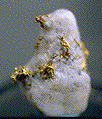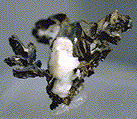

- Chemistry: Zn, elemental zinc
- Class: Native Elements
- Subclass: Native Metals
- Uses: Many applications for the metal - zinc.
Specimens
Native zinc is a rare mineral.
Native zinc has been found in several locations but is never found in any abundance.
It would be wrong to consider it an ore of zinc.
First of all, an ore should be less valuable than its constituent metal.
And since zinc is so rare in its native form, this is not true.
Secondly, an ore needs to be common enough and exploitable enough to be profitable enough to mine.
In other words, economical!
As already stated, native zinc is a rare mineral and in addition, it does not group itself in any siginificant concentrations.
Actual ores of zinc include
sphalerite,
smithsonite,
hemimorphite,
franklinite,
Native zinc's type locality is somewhat in doubt as different localities are sometimes mentioned. The Mina Dulcinea de Llampos, Copiapo, Chile locality seems to be the current type locality of concensus, however a case has been made for the first specimens of native zinc actually coming from New Brunswick, Victoria, Australia in 1855. Native zinc is found as indistinct grains in igneous rocks with originations from a reducing environment.
As an important industrial metal, zinc has been used for eons, even if its users did not know what it was. It was used to make the zinc/copper alloy brass in prehistoric times. A figure in the Bible, Tubal-cain, was mentioned as an instructor in brass and iron. The Bible says he was 7 genenerations from Adam. Prehistoric brass has been found in Romanian ruins. Romans made great use of brass and found it to be ornamental as well as useful. It is doubtful that the zinc metal was actually seen by its early users as it boils well below copper's melting point and thus can not be melted into the copper. More likely a technique was used that roasted the zinc ores with the copper and the resultant zinc fumes absorbed into the melting copper.
There are a few naturally occurring zinc alloys that are classified in the
Elements Class with native zinc.
Naturally occurring brass,
Cu3Zn2, is one of them.
It is being given consideration as a mineral, but is not yet officially recognized.
Other zinc alloy minerals include
PHYSICAL CHARACTERISTICS:
- Color is white to bright blue gray.
- Luster is metallic.
- Transparency: Specimens are opaque.
- Crystal System is hexagonal; 6/m 2/m 2/m.
- Crystal Habits include volcanic exhalations, granular (often microscopic) and lab grown specimens.
- Cleavage is perfect in one direction (basal).
- Hardness is 2.
- Specific Gravity is 6.9 - 7.2 (heavy even for a metallic mineral).
- Streak: Light gray.
- Other Characteristics: Brittle at room temperatures (not malleable or ductile unless heated to 100 degrees C).
- Associated Minerals include native gold, native copper, native aluminum and other rare native metals.
- Notable Occurrences include the type locality of Mina Dulcinea de Llampos, Copiapo, Chile and Elsa Mine, Keno Hill-Galena Hill area of the Yukon Territory, Canada as well as New Brunswick, Victoria and Forest Range Gold Mine, Australia; Tyrol, Austria; Amur, Yakutia; Chirynaisky Massif, Koryak Mts., Kamchatka Peninsula and Billeekh Intrusion, Siberia, Russia.
- Best Field Indicators are color, brittleness, hardness, locality and density.







